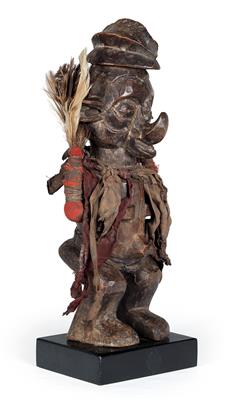Yaka (or Bayaka), Dem. Rep. of Congo: a magic figure of the Yaka, called ‘Biteki’, with typical upward-curving ‘Yaka’ nose and much magic material.
Yaka (or Bayaka), Dem. Rep. of Congo: a magic figure of the Yaka, called ‘Biteki’, with typical upward-curving ‘Yaka’ nose and much magic material.

Sculpted figures of the Yaka, in the south-west Congo, often have a particular, characteristic feature, especially on male representations: the upward-curving ‘Yaka nose’. Also the magical figure of the Yaka offered here displays this typical, curved up ‘Yaka nose’. These figures are placed in shrines and serve for protection and for defence against all evil, and for healing illness (some of them can, however, actually cause illness). They also play an important role in initiations and circumcisions. These figures draw their ‘power’ from the ‘magic material’ that the priests, healers and soothsayers, the ‘Nganga’, tie on to them, hang on them, or conceal in cavities in their bodies.
The present, male ‘Yaka biteki’ consists of very hard, light-coloured wood and is dyed dark brown. The head is covered with a cap carved out from the same piece. Consistent with the Yaka style, the ears protrude. The face is outlined from the forehead to the cheeks. The slit coffee bean eyes are deep-set. From the middle of the face, the large, typical ‘Yaka nose’ bends upwards, above a protruding chin with mouth. The arms are held close to the short, cylindrical body and are bent. The navel is accentuated and protruding, and displays a cavity for ‘magic material’. The legs and feet stand, slightly bent, firmly on the ground. The ‘magic material’, with which the priest ‘Nganga’ has charged up this figure of power, consists of two red fabric little bags with feathers, tied to the upper arms by means of raffia strips in holes, a double choker of fabric, on which many light brown and red fabric strips are tied, as well as of a fabric belt around the hips. The cavity in the navel is empty. An exceptionally interesting and typical Yaka sculpture, with insignificant cracks on the reverse, as well as with a very good, encrusted shiny, old patina through protracted use. There is an inventory number, in white letters, on the right foot underneath.
Height: 33 cm; width: c. 14 cm.
Early 20th century. (ME)
Provenance:
South African private collection.
Lit.:
‘Die Kunst des schwarzen Afrika’ by Kerchache, Paudrat, Stephan, ill. 757, 1037; ‘African Art in American Collections’ by Robbins & Nooter, ill. 1046, 1049; ‘The Tribal Arts of Africa’ by J. Baptiste Bacquart, p. 185, ill. 10; ‘100 Peoples of Zaire and their Sculpture’ by Marc L. Felix, S. 195, ill. 12.
Expert: Prof. Erwin Melchardt
 Prof. Erwin Melchardt
Prof. Erwin Melchardt
+43-1-515 60-465
erwin.melchardt@dorotheum.at
20.02.2017 - 14:00
- Vyvolávací cena:
-
EUR 800,-
Yaka (or Bayaka), Dem. Rep. of Congo: a magic figure of the Yaka, called ‘Biteki’, with typical upward-curving ‘Yaka’ nose and much magic material.
Sculpted figures of the Yaka, in the south-west Congo, often have a particular, characteristic feature, especially on male representations: the upward-curving ‘Yaka nose’. Also the magical figure of the Yaka offered here displays this typical, curved up ‘Yaka nose’. These figures are placed in shrines and serve for protection and for defence against all evil, and for healing illness (some of them can, however, actually cause illness). They also play an important role in initiations and circumcisions. These figures draw their ‘power’ from the ‘magic material’ that the priests, healers and soothsayers, the ‘Nganga’, tie on to them, hang on them, or conceal in cavities in their bodies.
The present, male ‘Yaka biteki’ consists of very hard, light-coloured wood and is dyed dark brown. The head is covered with a cap carved out from the same piece. Consistent with the Yaka style, the ears protrude. The face is outlined from the forehead to the cheeks. The slit coffee bean eyes are deep-set. From the middle of the face, the large, typical ‘Yaka nose’ bends upwards, above a protruding chin with mouth. The arms are held close to the short, cylindrical body and are bent. The navel is accentuated and protruding, and displays a cavity for ‘magic material’. The legs and feet stand, slightly bent, firmly on the ground. The ‘magic material’, with which the priest ‘Nganga’ has charged up this figure of power, consists of two red fabric little bags with feathers, tied to the upper arms by means of raffia strips in holes, a double choker of fabric, on which many light brown and red fabric strips are tied, as well as of a fabric belt around the hips. The cavity in the navel is empty. An exceptionally interesting and typical Yaka sculpture, with insignificant cracks on the reverse, as well as with a very good, encrusted shiny, old patina through protracted use. There is an inventory number, in white letters, on the right foot underneath.
Height: 33 cm; width: c. 14 cm.
Early 20th century. (ME)
Provenance:
South African private collection.
Lit.:
‘Die Kunst des schwarzen Afrika’ by Kerchache, Paudrat, Stephan, ill. 757, 1037; ‘African Art in American Collections’ by Robbins & Nooter, ill. 1046, 1049; ‘The Tribal Arts of Africa’ by J. Baptiste Bacquart, p. 185, ill. 10; ‘100 Peoples of Zaire and their Sculpture’ by Marc L. Felix, S. 195, ill. 12.
Expert: Prof. Erwin Melchardt
 Prof. Erwin Melchardt
Prof. Erwin Melchardt
+43-1-515 60-465
erwin.melchardt@dorotheum.at
|
Horká linka kupujících
Po-Pá: 10.00 - 17.00
kundendienst@dorotheum.at +43 1 515 60 200 |
| Aukce: | Mimoevropské a domorodé umění |
| Typ aukce: | Salónní aukce |
| Datum: | 20.02.2017 - 14:00 |
| Místo konání aukce: | Wien | Palais Dorotheum |
| Prohlídka: | 11.02. - 20.02.2017 |
